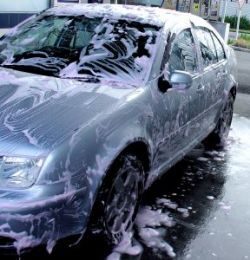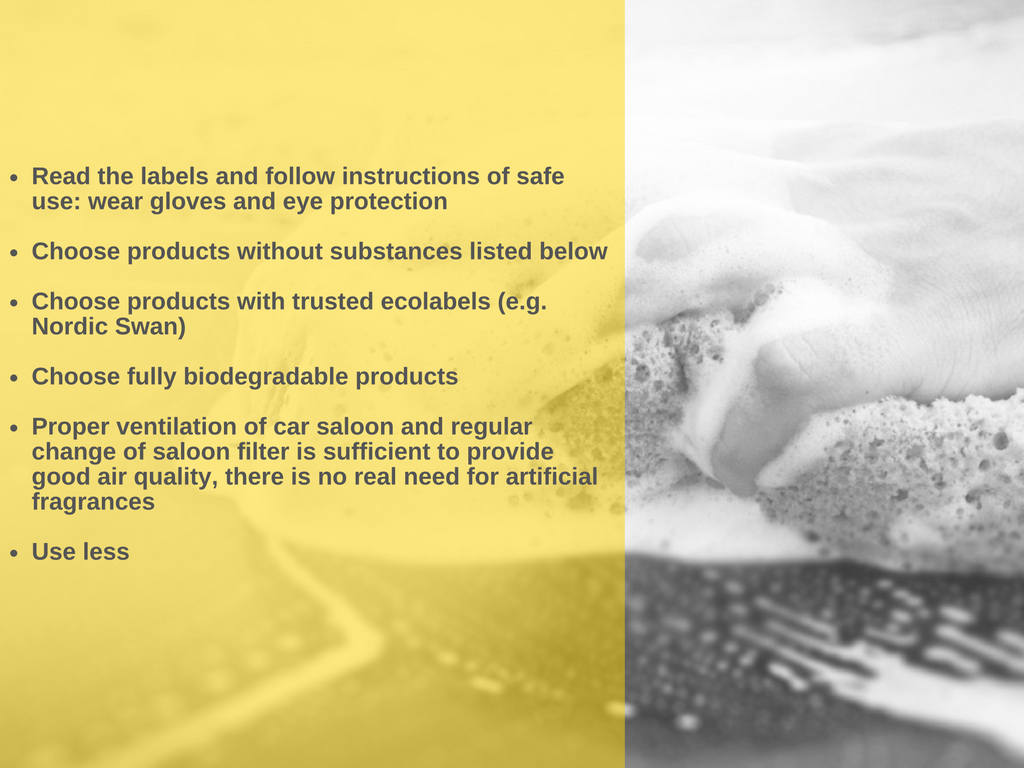How to choose safer car care products?
Car care products can contain hazardous substances that not only fulfill the functions they are foreseen to, but also may cause unwanted effects on your health and the environment around you.
The problem
An important reason to consider which type of car care products to buy is that the overall exposure to chemicals has significantly increased. Although exposure to specific substances may be seldom and involve only comparatively low amounts, there are so many chemicals that this adds up to an overall considerable exposure level. It is yet unknown how these multiple exposures affect the way hazardous substances impact on human health and the environment. Many scientists believe that this continuous “chemical stress” impairs the human immune system and is one of the causes for the increased incidents of allergies in the general population.
What is a car care product?
The following product types are addressed as car care products:
- Shampoo: cleaning agent for the outside of a car, normally used with water and sponge
- Varnish cleaner and polishes: products used to repair and polish weathered car varnish. They contain sanding materials and may be provided in combination with waxes. They are normally used either with polishing machines or using hand pads
- Hard waxes: products conserving the varnish surface. Hard waxes are normally applied using a soft cloth after cleaning and polishing the varnishes
- Window cleaner: cleaning agent which is either directly used on the windshield and other car windows or introduced into the wiping water for the windshield
- Rim or wheel cleaners: cleaners to be used on the rims and wheels and which may have to be selected depending on the rim materials (e.g. aluminium rims or coated rims may require specific cleaners).
- Cockpitspray: cleaners for plastic materials in the car saloon
- Motor cleaners: it is not recommended anymore to wash the motor, because many parts cannot be reached and electronic parts may be damaged by water. Therefore these should be fully avoided and are not discussed in this factsheet.

Some hazardous substances may not be avoidable in car care products; for example even the most advanced products may still contain some irritating substances. Therefore, it is also important to ensure that car care products are used safely. This includes wearing gloves and eye protection, to avoid spraying of products and to apply products which are rinsed off with water only in places, where the resulting waste water is collected and treated, preferably car washing stations.
Tips & tricks

Possible health and environmental concerns
Risk for humans
Consumers normally use car care products on their own cars, on the street where it is parked. The products are applied manually e.g. with cloths and frequently no specific protection measures, such as wearing gloves or safety googles are taken. The exposure of consumers to the car care products depends on how often and intensively they use them
As car care products are either used to remove dirt from parts of the car or to maintain the varnish of the autobody, the main hazardous ingredients are solvents, tensides, acids and bases and different types of additives.
The most frequently used solvents in car care products appear to be mineral oil destillates (naptha; heavy, medium and or light fractions), which may (contain substances which can) cause cancer and/or gene mutations. Many of these naphtha solvents may also cause so called aspiration hazards. This means substances may enter the lower respiratory system directly through nose or mouth and may cause severe pulmonary damage and/or inflammations. Other substances in car care products (mostly different types of alcohols) can cause corrosion or irritation of the skin and severe damage to eyes.
Consequently, contact with the car care products via the skin or through inhalation may cause health damage, depending on the amount and duration of exposure. Risks could therefore occur in any type of application of these products where the product is inhaled (e.g. spraying or evaporation inside the car saloon) or when the product is applied manually and gets in contact with the skin.
Risk for environment
In professional service stations / car washes, emissions of substances in car care products with the washing water / wastewater should be collected and pre-treated (in particular oils should be separated) before being discharged to the sewage system. Where substances in car care products for consumers end up depends on the location of the use and whether or not a sewage system (streets) would collect the substances, e.g. when being washed off the street.

Car care products may contain substances, which are toxic to the aquatic environment. A limited and random screening of 12 products on the market however showed that most of these are only moderately toxic. Hence, risks to the environment from the use of car care products are likely to be low, in particular as the most emission relevant processes, such as car washing, are to be performed in specific locations (car wash with wastewater capture and treatment).
Below is a table explaining the health effects of some of the hazardous chemicals used in car care products:
Uses
Solvents
Hazardous chemicals
Methanol Octamethylcyclotetrasiloxane Mineral oil destillates (naptha; heavy,medium and or light fractions)
Possible health & environmental effects
Very toxic, carcinogenic and mutagenic
Uses
Fragrances/ Perfume
Hazardous chemicals
Phthalates (DEHP, Bis (2-ethylhexylphthalat)Nitromusks, polycyclic musks (Galaxolide, Tonalide)
Possible health effects
Impaires fertility, harmful for the unborn childDisrupts the hormone system, allergen
Uses
Surfactants
Hazardous chemicals
Octamethylcyclotetrasiloxane Octylphenol (ethoxylates)Nonylphenol (ethoxylates)
Possible health effects
Disrupts the hormone system and fertility

